Photo
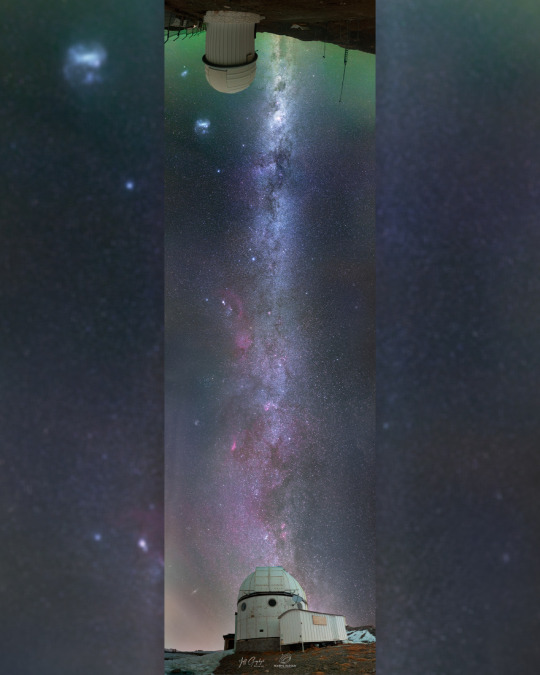
A 10 000 Kilometer Galactic Bridge : With this creative astro-collaboration you can follow the plane of our Milky Way Galaxy as it bridges northern and southern hemisphere skies. To construct the expansive composite nightscape, skies over Observatorio El Sauce in Chile (top) were imaged on the same date but 6 hours later than the skies over the Saint-Veran observatory in the French Alps. The 6 hour time-lag allowed Earth's rotation to align the Milky Way above domes at the two sites. All exposures were made with similar cameras and lenses mounted on simple tripods. A faint greenish airglow is visible in the dark Chilean sky that also features the Large and Small Magellanic Clouds near the observatory dome. In the French Alps light pollution is apparent, but the distant Andromeda Galaxy can still be spotted near the horizon in the northern night. On planet Earth the two observatories are separated by about 10,000 kilometers. via NASA
2K notes
·
View notes
Photo

Lunar Occultation of Venus : On May 27 Venus rose as the morning star, near the waning crescent Moon in a predawn sky already full of planets. It was close on the sky to the Moon's crescent and a conjunction of the second an third brightest celestial beacons were enjoyed by skygazers around the world. But seen from locations along a track through southeast Asia and the Indian Ocean the Moon actually passed in front of Venus in a lunar occultation. In this animated gif the 75 percent illuminated disk of Venus approaches and just begins to disappear behind the sunlit southwestern lunar limb. The telescopic frames used to construct it were captured from Reunion Island in the Indian Ocean around 4:50am local time, with the Moon and Venus very close to the eastern horizon. At the time Venus was over 180 million kilometers from Reunion Island, compared to a lunar distance of a mere 400 thousand kilometers or so. About 50 minutes later Venus emerged from behind the Moon. via NASA
616 notes
·
View notes
Photo

Tau Herculids Meteors over Kitt Peak Telescopes : It wasn't the storm of the century -- but it was a night to remember. Last night was the peak of the Tau Herculids meteor shower, a usually modest dribble of occasional meteors originating from the disintegrating Comet 73P/Schwassmann-Wachmann 3. This year, calculations showed that the Earth might be passing through a particularly dense stream of comet debris -- at best creating a storm of bright meteors streaking out from the constellation of Hercules. What actually happened fell short of a meteor storm, but could be called a decent meteor shower. Featured here is a composite image taken at Kitt Peak National Observatory in Arizona, USA accumulated over 2.5 hours very late on May 30. Over that time, 19 Tau Herculids meteors were captured, along with 4 unrelated meteors. (Can you find them?) In the near foreground is the Bok 2.3-meter Telescope with the 4.0-meter Mayall Telescope just behind it. Next year, the annual Tau Herculids are expected to return to its normal low rate, with the next active night forecast for 2049. via NASA
400 notes
·
View notes
Photo
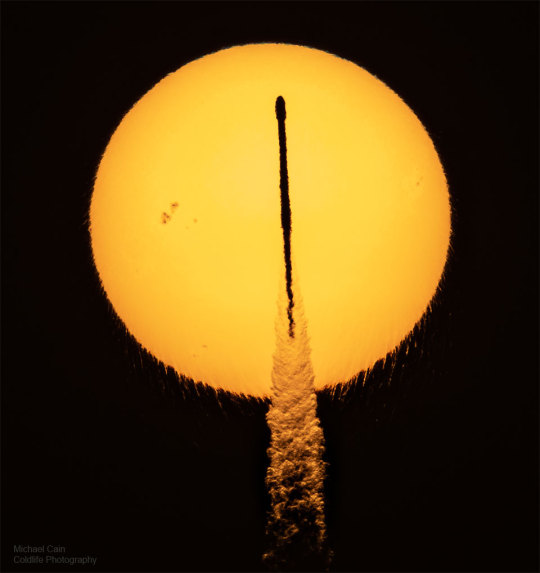
Rocket Transits Rippling Sun : The launch of a rocket at sunrise can result in unusual but intriguing images that feature both the rocket and the Sun. Such was the case last month when a SpaceX Falcon 9 rocket blasted off from NASA's Kennedy Space Center carrying 53 more Starlink satellites into low Earth orbit. In the featured launch picture, the rocket's exhaust plume glows beyond its projection onto the distant Sun, the rocket itself appears oddly jagged, and the Sun's lower edge shows peculiar drip-like ripples. The physical cause of all of these effects is pockets of relatively hot or rarefied air deflecting sunlight less strongly than pockets relatively cool or compressed air: refraction. Unaware of the Earthly show, active sunspot region 3014 -- on the upper left -- slowly crosses the Sun. via NASA
794 notes
·
View notes
Photo

Red Crepuscular Rays from an Eclipse : What's happening behind that island? Things both expected and unexpected. Expected, perhaps, the pictured rays of light -- called crepuscular rays -- originate from the Sun. Unexpected, though, the Sun was being partially eclipsed by the Moon at the time -- late last month. Expected, perhaps, the Sun's rays are quite bright as they shine through gaps in below-horizon clouds. Unexpected, though, the crepuscular rays are quite red, likely the result an abundance of aerosols in Earth's atmosphere scattering away much of the blue light. Expected, with hope, a memorable scene featuring both the Moon and the Sun, superposed. Unfortunately, from this location -- in Uruguay looking toward Argentina -- clouds obscured the eclipse -- which wasn't completely unexpected. However, after packing up to go home, the beauty of bright red crepuscular rays emerged -- quite unexpectedly. Oh -- and that island on the horizon -- it's really two islands. via NASA
1K notes
·
View notes
Photo
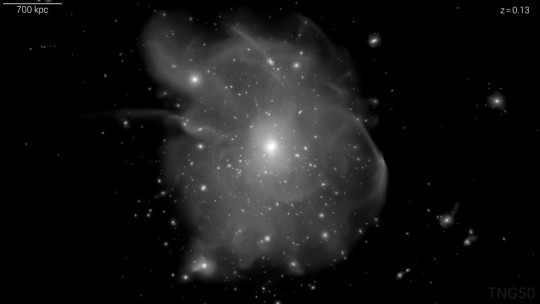
Simulation TNG50: A Galaxy Cluster Forms : How do clusters of galaxies form? Since our universe moves too slowly to watch, faster-moving computer simulations are created to help find out. A recent effort is TNG50 from IllustrisTNG, an upgrade of the famous Illustris Simulation. The first part of the featured video tracks cosmic gas (mostly hydrogen) as it evolves into galaxies and galaxy clusters from the early universe to today, with brighter colors marking faster moving gas. As the universe matures, gas falls into gravitational wells, galaxies forms, galaxies spin, galaxies collide and merge, all while black holes form in galaxy centers and expel surrounding gas at high speeds. The second half of the video switches to tracking stars, showing a galaxy cluster coming together complete with tidal tails and stellar streams. The outflow from black holes in TNG50 is surprisingly complex and details are being compared with our real universe. Studying how gas coalesced in the early universe helps humanity better understand how our Earth, Sun, and Solar System originally formed. via NASA
336 notes
·
View notes
Photo

RCW 86: Historical Supernova Remnant : In 185 AD, Chinese astronomers recorded the appearance of a new star in the Nanmen asterism. That part of the sky is identified with Alpha and Beta Centauri on modern star charts. The new star was visible for months and is thought to be the earliest recorded supernova. This deep image shows emission nebula RCW 86, understood to be the remnant of that stellar explosion. The narrowband data trace gas ionized by the still expanding shock wave. Space-based images indicate an abundance of the element iron and lack of a neutron star or pulsar in the remnant, suggesting that the original supernova was Type Ia. Unlike the core collapse supernova explosion of a massive star, a Type Ia supernova is a thermonuclear detonation on a a white dwarf star that accretes material from a companion in a binary star system. Near the plane of our Milky Way galaxy and larger than a full moon on the sky this supernova remnant is too faint to be seen by eye though. RCW 86 is some 8,000 light-years distant and around 100 light-years across. via NASA
781 notes
·
View notes
Photo

Titan: Moon over Saturn : Like Earth's moon, Saturn's largest moon Titan is locked in synchronous rotation. This mosaic of images recorded by the Cassini spacecraft in May of 2012 shows its anti-Saturn side, the side always facing away from the ringed gas giant. The only moon in the solar system with a dense atmosphere, Titan is the only solar system world besides Earth known to have standing bodies of liquid on its surface and an earthlike cycle of liquid rain and evaporation. Its high altitude layer of atmospheric haze is evident in the Cassini view of the 5,000 kilometer diameter moon over Saturn's rings and cloud tops. Near center is the dark dune-filled region known as Shangri-La. The Cassini-delivered Huygens probe rests below and left of center, after the most distant landing for a spacecraft from Earth. via NASA
316 notes
·
View notes
Photo
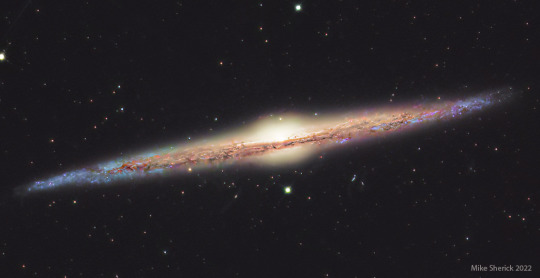
NGC 4565: Galaxy on Edge : Magnificent spiral galaxy NGC 4565 is viewed edge-on from planet Earth. Also known as the Needle Galaxy for its narrow profile, bright NGC 4565 is a stop on many telescopic tours of the northern sky, in the faint but well-groomed constellation Coma Berenices. This sharp, colorful image reveals the galaxy's boxy, bulging central core cut by obscuring dust lanes that lace NGC 4565's thin galactic plane. NGC 4565 itself lies about 40 million light-years distant and spans some 100,000 light-years. Easily spotted with small telescopes, sky enthusiasts consider NGC 4565 to be a prominent celestial masterpiece Messier missed. via NASA
807 notes
·
View notes
Photo

The Lively Center of the Lagoon Nebula : The center of the Lagoon Nebula is a whirlwind of spectacular star formation. Visible near the image center, at least two long funnel-shaped clouds, each roughly half a light-year long, have been formed by extreme stellar winds and intense energetic starlight. A tremendously bright nearby star, Herschel 36, lights the area. Vast walls of dust hide and redden other hot young stars. As energy from these stars pours into the cool dust and gas, large temperature differences in adjoining regions can be created generating shearing winds which may cause the funnels. This picture, spanning about 10 light years, combines images taken in six colors by the orbiting Hubble Space Telescope. The Lagoon Nebula, also known as M8, lies about 5000 light years distant toward the constellation of the Archer (Sagittarius). via NASA
2K notes
·
View notes
Photo

A Deep Sky Behind an Eclipsed Moon : The plan was to capture a picturesque part of the sky that was hosting an unusual guest. The result included a bonus — an additional and unexpected guest. The beautiful background features part of the central band of our Milky Way galaxy on the far left, and the colorful clouds of Rho Ophiuchi in the image center. The unusual guest, a dimmed and reddened Moon on the right, was expected because the image was taken during last week’s total lunar eclipse. The timing had to be right because the Moon — both before and after eclipse — would be so bright it would overwhelm the background. The unexpected guest was the bright meteor across the image center. The fleeting meteor streak was captured on only one of the 10 consecutively-captured deep-field images from La Palma in the Spanish Canary Islands, while the eclipsed Moon image was taken immediately afterwards with the same camera and from the same location. The next total lunar eclipse — also quite expected — will occur in early November. via NASA
648 notes
·
View notes
Photo
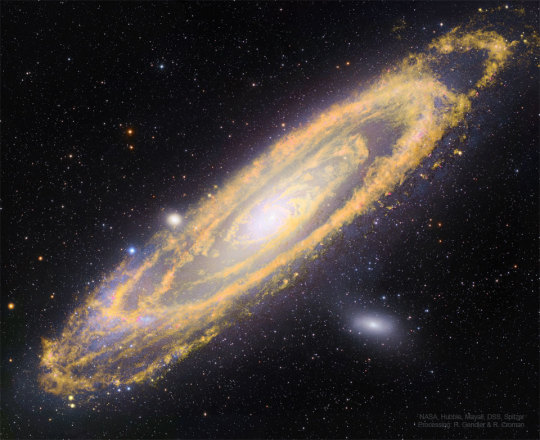
The Once and Future Stars of Andromeda : This picture of Andromeda shows not only where stars are now, but where stars will soon be. Of course, the big, beautiful Andromeda Galaxy, M31, is a spiral galaxy -- and a mere 2.5 million light-years away. Both space-based and ground-based observatories have been here combined to produce this intriguing composite image of Andromeda, at wavelengths both inside and outside normally visible light. The visible light shows where M31's stars are now -- as highlighted in white and blue hues and imaged by the Hubble, Subaru, and Mayall telescopes. The infrared light shows where M31's future stars will soon form -- as highlighted in orange hues and imaged by NASA's Spitzer Space Telescope. The infrared light tracks enormous lanes of dust, warmed by stars, sweeping along Andromeda's spiral arms. This dust is a tracer of the galaxy's vast interstellar gas -- the raw material for future star formation. These new stars will likely form over the next hundred million years, surely well before Andromeda merges with our Milky Way Galaxy in about 5 billion years. via NASA
1K notes
·
View notes
Photo
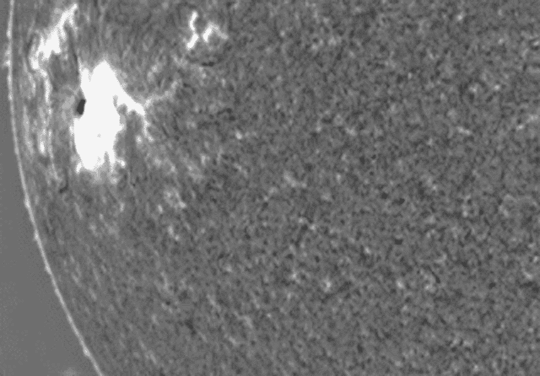
A Large Tsunami Shock Wave on the Sun : Tsunamis this large don't happen on Earth. During 2006, a large solar flare from an Earth-sized sunspot produced a tsunami-type shock wave that was spectacular even for the Sun. Pictured here, the tsunami wave was captured moving out from active region AR 10930 by the Optical Solar Patrol Network (OSPAN) telescope in New Mexico, USA. The resulting shock wave, known technically as a Moreton wave, compressed and heated up gasses including hydrogen in the photosphere of the Sun, causing a momentarily brighter glow. The featured image was taken in a very specific red color emitted exclusively by hydrogen gas. The rampaging tsunami took out some active filaments on the Sun, although many re-established themselves later. The solar tsunami spread at nearly one million kilometers per hour, and circled the entire Sun in a matter of minutes. via NASA
1K notes
·
View notes
Photo

Planetary Nebula Abell 7 : Very faint planetary nebula Abell 7 is some 1,800 light-years distant, just south of Orion in planet Earth's skies in the constellation Lepus, The Hare. Surrounded by Milky Way stars and near the line-of-sight to distant background galaxies, its generally simple spherical shape, about 8 light-years in diameter, is outlined in this deep telescopic image. Within its confines are beautiful, more complex details enhanced by the use of narrowband filters. Emission from hydrogen is shown in reddish hues with oxygen emission mapped to green and blue colors, giving Abell 7 a natural appearance that would otherwise be much too faint to be appreciated by eye. A planetary nebula represents a very brief final phase in stellar evolution that our own Sun will experience 5 billion years hence, as the nebula's central, once sun-like star shrugs off its outer layers. Abell 7 itself is estimated to be 20,000 years old. Its central star is seen here as a fading white dwarf some 10 billion years old. via NASA
586 notes
·
View notes
Photo

A View from Earth s Shadow : This serene sand and skyscape finds the Dune of Pilat on the coast of France still in Earth's shadow during the early morning hours of May 16. Extending into space, the planet's dark umbral shadow covered the Moon on that date. From that location the total phase of a lunar eclipse had begun before moonset. Still in sunlight though, the International Space Station crossed from the western horizon and Earth's largest artificial moon traced the bright flat arc through the sky over 400 km above. Simply constructed, the well-planned panoramic scene was captured over a 5 minutes in a series of consecutive images. via NASA
407 notes
·
View notes
Photo

A Digital Lunar Eclipse : Recorded on May 15/16 this sequence of exposures follows the Full Moon during a total lunar eclipse as it arcs above treetops in the clearing skies of central Florida. A frame taken every 5 minutes by a digital camera shows the progression of the eclipse over three hours. The bright lunar disk grows dark and red as it glides through planet Earth's shadow. In fact, counting the central frames in the sequence measures the roughly 90 minute duration of the total phase of this eclipse. Around 270 BC, the Greek astronomer Aristarchus also measured the duration of total lunar eclipses, but probably without the benefit of digital watches and cameras. Still, using geometry he devised a simple and impressively accurate way to calculate the Moon's distance in terms of the radius of planet Earth, from the eclipse duration. via NASA
665 notes
·
View notes
Photo

A Jewel on the Flower Moon : Cloudy skies plagued some sky watchers on Sunday as May's Full Flower Moon slipped through Earth's shadow in a total lunar eclipse. In skies above Chile's Atacama desert this telephoto snapshot still captured an awesome spectacle though. Seen through thin high cirrus clouds just before totality began, a last sliver of sunlit crescent glistens like a hazy jewel atop the mostly shadowed lunar disk. This full moon was near perigee, the closest point in its elliptical orbit. It passed near the center of Earth's dark umbral shadow during the 90 minute long total eclipse phase. Faintly suffused with sunlight scattered by the atmosphere, the umbral shadow itself gave the eclipsed moon a reddened appearance and the very dramatic popular moniker of a Blood Moon. via NASA
720 notes
·
View notes